Best Whole House Generators 2024
- January 17, 2024
- 1 comment
Brace yourself for winter’s chill without fear of power outages. In our quest for warmth and safety, we’ve identified the best whole house generators to shield your home from the season’s unpredictability. Whether it’s a blizzard’s wrath or a routine power failure, these robust generators ensure your comfort and security, making winter outages a worry of the past. Join us as we unveil the top picks that promise to keep your home powered through winter and beyond.
List of Whole Home Generators 2024:
- Generac Guardian Wi-Fi Enabled Standby Generator
- Briggs & Stratton 12,000-Watt Automatic Air Cooled Standby Generator
- Generac PowerPact 7,500 Watt Standby Generator
- Champion 14-kW aXis Home Standby Generator with 200-Amp Whole House Switch
- Generac Guardian 3-Phase 20kW Automatic Standby Generator Wi-Fi Enabled
What Is a Whole House Generator?
A whole house generator stands as a steadfast guardian of your home’s power continuity. Unlike its standby or portable counterparts, this robust system is designed to shoulder the entire electrical load of your home, seamlessly activating to keep every room powered during an outage. Directly wired into your electric panel, it detects power interruptions in real-time and springs into action without manual intervention. As long as it’s adequately fueled, a whole house generator ensures that from your essential lights and heating systems to your most demanding appliances, every facet of your home operates uninterrupted, regardless of external power fluctuations.
1. Generac Guardian WIFI Enabled 10000-Watt Dual Fuel Home Standby Generator
Specifications
- Rated Wattage (LP/Natural Gas): 10,000 Watts (LP) / 9,000 Watts (Natural Gas)
- Engine: Generac G-Force Engine, 460cc displacement
- Fuel Type: Dual Fuel – Liquid Propane / Natural Gas
- Operational Volume: Standard (above 60 dB)
- Cooling Method: Air cooled
- Dimensions: Height – 29 inches, Length – 48 inches, Width – 25 inches
- Weight: 338 lbs
- Full Load Fuel Consumption: 1.48 GPH (LP), 127 CPH (Natural Gas)
- Automatic Voltage Regulation: Yes
- Low Oil Shutdown: Yes
The Generac Guardian WIFI Enabled 10000-Watt Dual Fuel Home Standby Generator stands as a testament to Generac’s commitment to quality and innovation, securing its position as the #1 selling home standby generator brand. Engineered and built in the U.S.A., this generator is not just a purchase but an investment in reliability and peace of mind. With its capacity to provide whole-house backup power, it seamlessly connects to your existing LP or natural gas fuel supply, ensuring an automatic, rapid response to power outages. The G-Force Engine, specifically designed for the rigors of generator use, promises reliable power with minimal maintenance, setting it apart from its competitors.
Generac Guardian WIFI Enabled 10000 Pros and Cons
Pros
- Runs efficiently on both natural gas and liquid propane, offering flexibility and convenience in fuel choice. 2.
- The Generac G-Force Engine is purpose-built to handle generator use, offering reliability and reduced maintenance needs.
- With a corrosion-resistant finish and all-aluminum enclosures, it’s built to withstand adverse weather conditions.
- Includes an LCD controller for tracking maintenance intervals, and the Evolution Controller for easy monitoring of battery status and other vital metrics.
Cons
- Weighing 338 lbs with dimensions that are relatively large, it may require substantial space and might be challenging to move.
- The absence of an included automatic transfer switch means an additional purchase and installation are necessary for full automation during power outages.
- With a standard operational volume above 60 dB, it may not be the quietest option available, potentially being a consideration for noise-sensitive environments.
2. Briggs & Stratton 12,000-Watt Automatic Air Cooled Standby Generator
Specifications
- Rated Wattage: 12,000 Watts
- Engine: Briggs & Stratton Engine, 627cc displacement
- Fuel Type: Dual Fuel – Natural Gas, Propane
- Operational Volume: 64 dB
- Dimensions: Height – 37.2 inches, Length – 28 inches, Width – 26.1 inches
- Weight: 361 lbs
- Full Load Fuel Consumption: 2.26 gallons/hour
- Automatic Voltage Regulation: Yes
The Briggs & Stratton 12,000-Watt Automatic Air Cooled Standby Generator emerges as a robust and reliable solution for maintaining power during outages. Offering the capability to start a 5-ton air conditioner on 50% load, this compact generator doesn’t compromise on power. Its standout feature, Amplify Power Management, allows for smart prioritization of household power needs, ensuring that your most essential appliances stay running during an outage. This, coupled with the innovative InfoHub Wifi Wireless Monitoring, offers unparalleled control and peace of mind, allowing users to monitor and manage their generator remotely. The Vanguard V-Twin vertical engine at its core promises durability and performance that’s hard to match.
Briggs & Stratton 12,000-Watt Pros and Cons
Pros
- Amplify Power Management system and the Standby Generator Management smartphone app allow for strategic power distribution and monitoring.
- The Vanguard V-Twin vertical engine is engineered for durability and reliable performance.
- InfoHub Wifi Wireless Monitoring enables remote check-ups on the generator, ensuring readiness for outages.
- Features a low idle mode for reduced fuel consumption and lesser noise, making it an economical choice.
Cons
- Weighing 361 lbs and with sizable dimensions, installation, and placement require careful planning.
- With a noise level of 64 dB, it may not be the quietest option available, a consideration for residential areas or noise-sensitive environments.
- Full use of the InfoHub monitoring feature requires a subscription, an additional cost to consider.
3. Generac Powerpact 7500- Watt Home Standby Generator
Specifications
- Rated Wattage: 7.5 kW
- Fuel Type: Dual Fuel – Natural Gas or LP Gas
- Power Source: Natural Gas or LP Gas
- Recommended Uses: Primarily for Residential use
- Voltage: 240 Volts
- Output Wattage: 7500 Watts
- Product Dimensions: 36″L x 27″W x 25″H
- Engine Type: Generac OHV Engine
- Engine Displacement: 420 Cubic Centimeters
- Frequency: 60 Hz
The Generac PowerPact 7500-Watt Home Standby Generator emerges as an affordable, yet reliable solution for residential backup power needs. Boasting a suite of features that ensure convenience and performance, this generator is designed to power the essentials of your home seamlessly during power outages. The included 50-amp, NEMA 1 lightweight transfer switch automates the transition from utility to backup power, safeguarding your home’s critical appliances without the need for manual setup. Generac’s commitment to quality is evident in the purpose-built OHV engine and the advanced True Power Technology, ensuring clean, stable, and reliable power delivery.
Generac Powerpact 7500 Pros and Cons
Pros
- True Power Technology, offers consistent 7.5kW power with less than 5 percent total harmonic distortion, ensuring the safe operation of sensitive electronics.
- While installation by a certified electrician is recommended, the generator is designed for straightforward setup, saving time and reducing complexity.
- Features like low oil shutdown, automatic voltage regulation, and automatic idle control enhance the usability and safety of the generator.
- Its fully enclosed design not only protects the components but also contributes to a neat and compact footprint, making it suitable for residential use.
Cons
- While sufficient for powering essential circuits, its 7.5 kW output may not cover an entire household during extended outages.
4. Champion Power Equipment 14000-Watt 14kW Home Standby Generator System
Specifications
- Rated Wattage: 14,000 Watts (Propane), 12,500 Watts (Natural Gas)
- Fuel Type: Dual Fuel – Propane (LPG), Natural Gas (NG)
- Power Source: Battery Powered
- Operational Volume: 62 dB
- Dimensions: 52″L x 32.1″W x 52.1″H
- Weight: 482 pounds
- Voltage: 24 Volts
- Engine Type: 4-Stroke, 754 Cubic Centimeters displacement
- Tank Volume: 5 Gallons
The Champion Power Equipment 14000-Watt 14kW Home Standby Generator System is a powerhouse, ensuring your home remains operational even during extensive power outages. This generator is not just about delivering power; it’s about delivering smart power. The aXis ATS200 Whole House Automatic Transfer Switch offers managed power for your entire home, including the ability to handle unlimited high-demand loads with 4 priority levels. The generator’s quiet operation is another significant advantage. Thanks to advanced sound dampening and a specially designed low-tone muffler, it operates at a comfortable 62 dBA noise level, making it one of the quietest in its class.
Champion Power Equipment 14000 Pros and Cons
Pros
- The aXis ATS200 Whole House Automatic Transfer Switch provides comprehensive power management with a Wi-Fi setup, ensuring your entire home stays powered.
- Operates at a 62 dBA noise level thanks to advanced sound dampening and a specially designed low-tone muffler.
- The 24-volt starting system ensures reliable operation in extreme temperatures, from -22° F to 104° F, without the need for a cold weather kit.
- Provides 14,000 watts of continuous power on propane and 12,500 watts on natural gas, ensuring your home’s power needs are met without interruption.
Cons
- The generator’s substantial weight (482 pounds) and size require careful consideration for installation and placement.
- The large dimensions (52″L x 32.1″W x 52.1″H) may require significant space and planning, and may not blend seamlessly into all outdoor spaces. 3.
- The robust features and advanced technology come with a higher initial cost, which might be a consideration for budget-conscious buyers.
5. Generac Guardian 20,000-Watt Whole House Generator
Specifications
- Fuel Type: Dual Fuel – Natural Gas, Propane
- Power Source: Connected to existing LP or natural gas fuel supply
- Operational Volume: 66 dB
- Dimensions: Height – 29 inches, Length – 48 inches, Width – 25 inches
- Weight: 492 pounds
- Engine: OEM Branded Engine, 999cc displacement
- Response Time: Quick response time of 10 seconds to power loss
- Included Component: Automatic Transfer Switch
- Running Wattage: 20,000 Watts
The Generac Guardian 20,000-Watt Whole House Generator solidifies its status as a comprehensive solution for extensive residential power needs. Designed to engage within seconds of a power outage, this generator connects to your existing LP or natural gas fuel supply, ensuring your home’s power is uninterrupted. The 200 Amp, NEMA 3R (aluminum outdoor enclosure) smart switch offers up to whole house protection, making it a reliable safeguard for your family and your home. Generac’s True Power Technology promises clean and smooth operation of sensitive electronics and appliances, delivering best-in-class power quality with less than 5% total harmonic distortion.
Generac Guardian 20,000-Watt Pros and Cons
Pros
- The 200 Amp smart switch offers extensive coverage, ensuring your entire home stays powered during outages.
- True Power Technology ensures less than 5% total harmonic distortion, providing safe and smooth operation for sensitive electronics.
- The purpose-built, pressure-lubricated engine is designed for the rigors of generator use, offering more reliable power and requiring less routine maintenance.
- Features Quiet-Test self-test mode, which runs at a lower RPM for a quieter operation and less fuel consumption during its 5 or 12-minute test cycles.
- Mobile Link remote monitoring allows you to keep an eye on your generator’s status from anywhere in the world.
Cons
- Weighing 492 lbs and with substantial dimensions, it requires careful consideration for installation space and logistics.
- At 66 dB, it may not be the quietest option, which could be a factor for noise-sensitive environments.
- While the remote monitoring feature is highly convenient, it’s important to note that it is sold separately and not included with the generator.
Comparison Table of the Best Home Generators
| Feature/Generator | Generac Guardian 10000W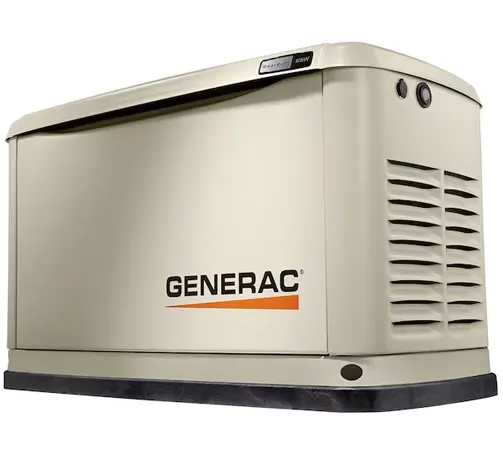 | Briggs & Stratton 12KW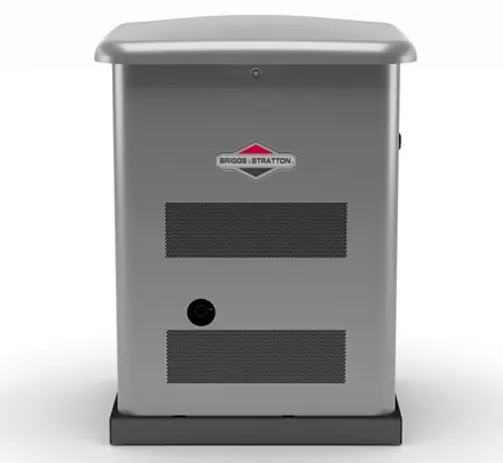 | Champion Power Equipment 14KW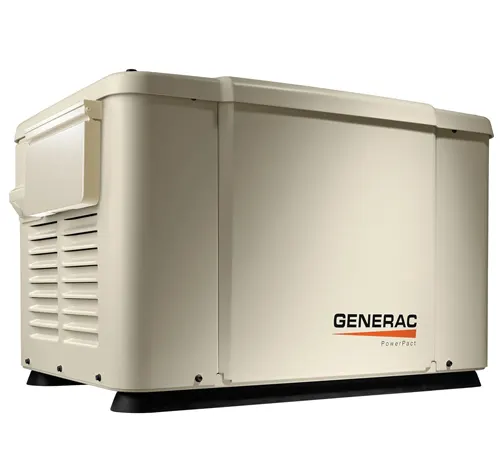 | Generac Powerpact 7500W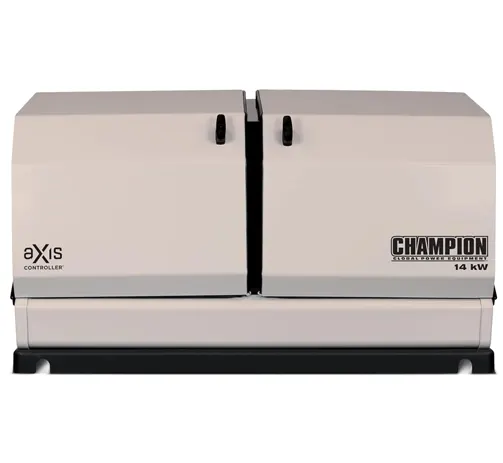 | Generac Guardian 20KW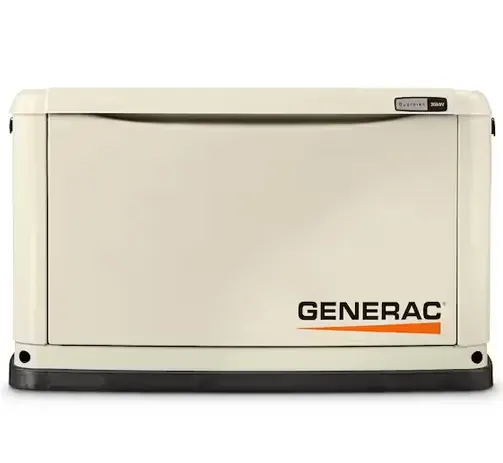 |
|---|---|---|---|---|---|
| Wattage Output | 10,000 Watts | 12,000 Watts | 14,000 Watts | 7,500 Watts | 20,000 Watts |
| Cooling System | Air-cooled | Air-cooled | Air-cooled | Air-cooled | Air-cooled |
| Fuel Type | Dual Fuel | Dual Fuel | Dual Fuel | Dual Fuel | Dual Fuel |
| Operational Volume (dB) | Above 60 dB | 64 dB | 62 dB | 69dB | 66 dB |
| Weight | 338 lbs | 361 lbs | 482 lbs | 380 lbs | 492 lbs |
How to Determine Which Whole House Generator Is Best for You
Selecting the perfect house generator involves a meticulous assessment of your specific needs and preferences. Here’s a guide to help you navigate through the crucial factors to consider, ensuring that you make an informed decision tailored to your unique situation.
- Power Requirements: Understanding your power needs is fundamental. Use an online wattage calculator, check appliance wattage, or analyze your electrical bill to estimate your power consumption. Remember, it’s prudent to add a 50% margin to your total wattage calculation for safety and unexpected needs. Typically, small to medium-sized U.S. homes require a generator with at least 8,500 to 10,000 watt output.
- Cooling Mechanisms: Choose between air-cooled and liquid-cooled generators based on efficiency and longevity, especially in warmer climates. Air-cooled generators are simpler but may not endure prolonged use as efficiently as liquid-cooled generators, which are better suited for high-temperature environments due to their sophisticated cooling mechanism.
- Fuel Types: Decide whether liquid propane or natural gas best suits your needs. Propane is cost-effective and cleaner, while natural gas offers convenience, especially if you’re not off-grid. Ensure your generator matches your fuel choice or can switch between fuel types.
- Budget: Your budget dictates your generator options. While ensuring uninterrupted power, align your choice with your financial capacity. Balance the cost with your essential power needs, and remember that larger, house capacity generators will be a more significant investment.
- Transfer Switch: The transfer switch is a vital component, linking your generator to your home’s electrical system. Ensure you choose a transfer switch that matches your generator’s capacity for efficient power distribution. Decide between the convenience of an automatic transfer switch and the cost-effectiveness of a manual one.
- Noise Level: Consider the operational noise levels, which can vary significantly. Placement and sound-proofing measures might be necessary, especially in residential areas where noise can be a concern.
By carefully evaluating these factors, you can select a house generator that not only meets your power requirements but also fits within your budget, operates efficiently in your climate, and integrates seamlessly into your home environment.
Overall Conclusion
Choosing the right whole home generator involves careful consideration of your specific needs, preferences, and circumstances. From the Generac Guardian 10000W’s WIFI-enabled convenience and environmental resilience to the Briggs & Stratton 12KW’s robust power management and remote monitoring capabilities, each generator has unique features tailored to different requirements.
The Champion Power Equipment 14KW stands out for its quiet operation and whole-house power management, making it a solid choice for those prioritizing tranquility and comprehensive coverage. On the other hand, the Generac Powerpact 7500W offers a more budget-friendly option with essential features like low oil shutdown and automatic voltage regulation, suitable for smaller homes or less intensive power needs.
Lastly, the Generac Guardian 20KW delivers a formidable power output, ideal for larger homes or those with higher power demands. Its True Power Technology and Mobile Link Remote Monitoring make it a top-tier choice for seamless integration and peace of mind.
Overall Pick: Generac Guardian 20KW
The Generac Guardian 20KW emerges as the overall pick for its blend of high power output, advanced technology features, and reliability. Its capacity to handle extensive power requirements, coupled with innovative features like True Power Technology and Mobile Link Remote Monitoring, offer an unmatched level of convenience and control. While it’s on the higher end in terms of investment, its comprehensive coverage, durability, and ease of use make it a worthwhile choice for those seeking a long-term, robust solution for their whole-house power needs.
FAQs
- How does a whole house generator differ from a portable generator?
A whole house generator is permanently installed and automatically powers your entire home during an outage. In contrast, a portable generator is mobile, requires manual operation, and typically powers only a few appliances or systems at a time. - Can a whole house generator power my home indefinitely during an outage?
While a whole house generator can power your home for extended periods, its runtime depends on the fuel supply. With a consistent fuel source, it can keep your home powered for days or even weeks, depending on the generator’s capacity and fuel efficiency. - What types of fuel can whole house generators use?
Whole house generators commonly use natural gas, propane, or diesel. The choice often depends on availability, cost, and personal preference. - Are whole house generators noisy?
Modern whole house generators are designed to operate quietly, although they are not silent. Many models come with sound-attenuating features to minimize noise, making them quieter than their portable counterparts. - How often should I maintain my whole house generator?
Regular maintenance is crucial for the longevity and efficiency of your generator. It’s generally recommended to perform a thorough check at least once a year, but consulting the manufacturer’s guidelines or a professional technician for a tailored maintenance schedule is best. - Can I install a whole house generator myself?
Installing a whole house generator involves complex electrical and gas plumbing work and should comply with local codes and regulations. Therefore, it’s highly recommended to have it installed by a certified professional. - How do I determine the right size for my whole house generator?
The size depends on your home’s power needs. Calculate the total wattage of the essential appliances and systems you want to run during an outage and consult with a professional to determine the appropriate generator size. - What safety precautions should I take with a whole house generator?
Ensure proper installation by a certified technician, regular maintenance, and adequate ventilation to prevent carbon monoxide poisoning. Also, install carbon monoxide detectors in your home and never try to modify the generator’s systems on your own.
Join the discussion below by sharing your experiences, tips, or reviews. Your contributions help others make informed decisions and navigate their chainsaw choices with confidence. Let’s build a community of shared knowledge for all wood-cutting enthusiasts!

David Murray
Forestry AuthorI'm David Murry, a forestry equipment specialist with a focus on chainsaw operation. With over 13 years of experience, I've honed my skills in operating and maintaining a wide range of machinery, from chainsaws to log splitters. My passion for the outdoors and commitment to sustainable forestry drive my work, which emphasizes safety, efficiency, and staying updated with industry advancements. Additionally, I'm dedicated to sharing my expertise and promoting environmental awareness within the forestry community.













This was a very informative and thorough overview of whole home generator options. I appreciate the in-depth details provided on each model as well as the buying guide tips. The comparison table makes it easy to evaluate features across different generators. Thanks for the excellent research that will help many homeowners make an educated choice.
Alex McGill
January 31, 2024 12:23 pm